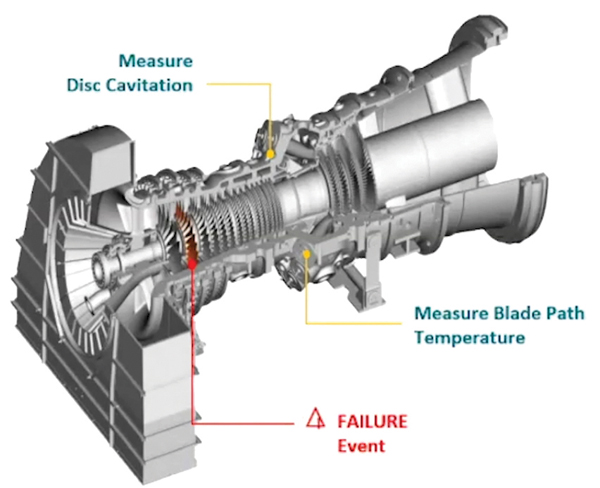Former US Defence Secretary Donald Rumsfeld once divided the world into “knowns, known unknowns, and unknown unknowns.” The latter has been more a subject for philosophical musing than practical study, but with increasing computing power and its ability to sift patterns out of vast amounts of data, the arrival of machine learning makes it practical in more situations. Systems are now available to identify potential problems in critical, high-performance equipment that operators didn’t even know how to look for, and help diagnose them before they turn into costly equipment failures.
 SparkCognition’s AI system, using standard sensing equipment, detected a never-before-seen data cluster that represented a “walking” turbine blade beginning to work itself loose.
A recent example: because of a unique manufacturing defect, a retaining pin in a compressor-stage fan blade in a gas-fired power turbine failed, which would eventually have meant the blade working loose, causing massive damage to the entire turbine. There was no history (anywhere) of this failure mode and no particular sensor had been set up to detect such a failure – or maybe even could have been. However a computer-based machine learning system identified an unanticipated combination of nuanced vibration and thermal stress that prompted the operator to shut it down and take a look. Result: savings of half a million to a million dollars in repairs, plus avoided loss of a month’s worth of operation, worth some $13 million.
SparkCognition’s AI system, using standard sensing equipment, detected a never-before-seen data cluster that represented a “walking” turbine blade beginning to work itself loose.
A recent example: because of a unique manufacturing defect, a retaining pin in a compressor-stage fan blade in a gas-fired power turbine failed, which would eventually have meant the blade working loose, causing massive damage to the entire turbine. There was no history (anywhere) of this failure mode and no particular sensor had been set up to detect such a failure – or maybe even could have been. However a computer-based machine learning system identified an unanticipated combination of nuanced vibration and thermal stress that prompted the operator to shut it down and take a look. Result: savings of half a million to a million dollars in repairs, plus avoided loss of a month’s worth of operation, worth some $13 million.
Machine failures usually fall into one of three categories:
• Unknown failure modes: machine learning solutions can identify all the various behaviors for a piece of equipment and present new anomalies in the sensor data that may never have occurred before, and where modelling may not be able to predict failure, but will notify the operator that something in the system has changed – as in the example above;
• Known but irregular failure modes: when predictability is poor, machine learning can present failure alerts based on deviation from what is considered “normal” system behaviour;
• Known and frequent failure modes, where behaviour matches a known and consistent failure pattern – the kind that operators have scheduled outages for. Even here, machine learning can help optimize scheduled downtime, for more efficient operation – with this approach the customer can get better at approximating failure timing and help maximize resources (inventory & labor) for repair.
SparkCognition in Texas is one company providing machine learning systems that improve predictive maintenance in sophisticated power equipment, such as gas and steam turbines, generators, HRSGs, condensers, pumps, and compressors. SparkCognition itself will develop and deploy its solution, looking after the process of collecting data for the initial model, building the machine learning model, validating it, and then deploying it in a streaming architecture.
Central to machine learning is the model building and analysis – the sensing devices most involved are the usual ones: vibration, pressure and temperature being the most common. For certain assets the system can also use flow and other process data. In some cases additional features can be derived, drawn from combinations of sensor readings.
Emerging computer technologies, generally categorized as machine learning, once fed a year’s worth or more of historical equipment sensor data, will build a simulation model of the equipment’s operation and develop an “understanding” of the system well enough to recognize patterns indicating potential trouble. They are expected to find subtle patterns that would previously have remained hidden until expensive disaster struck.
Product Marketing Manager Gabe Prado explains that the quality of starting data is going to be different for every customer. The company will evaluate the available data set and make recommendations as to its suitability in building a model, or whether a more complete or detailed data set is advisable. Additional or specialized sensors can also be integrated into the model.
Costs depend on the assets in scope (how many and what types of models must be built) and how the customer wants to deploy the system (e.g., do they need a specific user interface? What data infrastructure is already in place? Does Sparkcognition need to build a connector to their database?). The solution adds value in terms of improved production, cost savings, and risk mitigation, often far outpacing the initial investment, Mr. Prado advises.
In addition to combined cycle power plants, the company has also deployed its systems at plant-wide scale into offshore oil and gas production platforms and chemical refineries, and has done work on other individual assets in various other industries.
